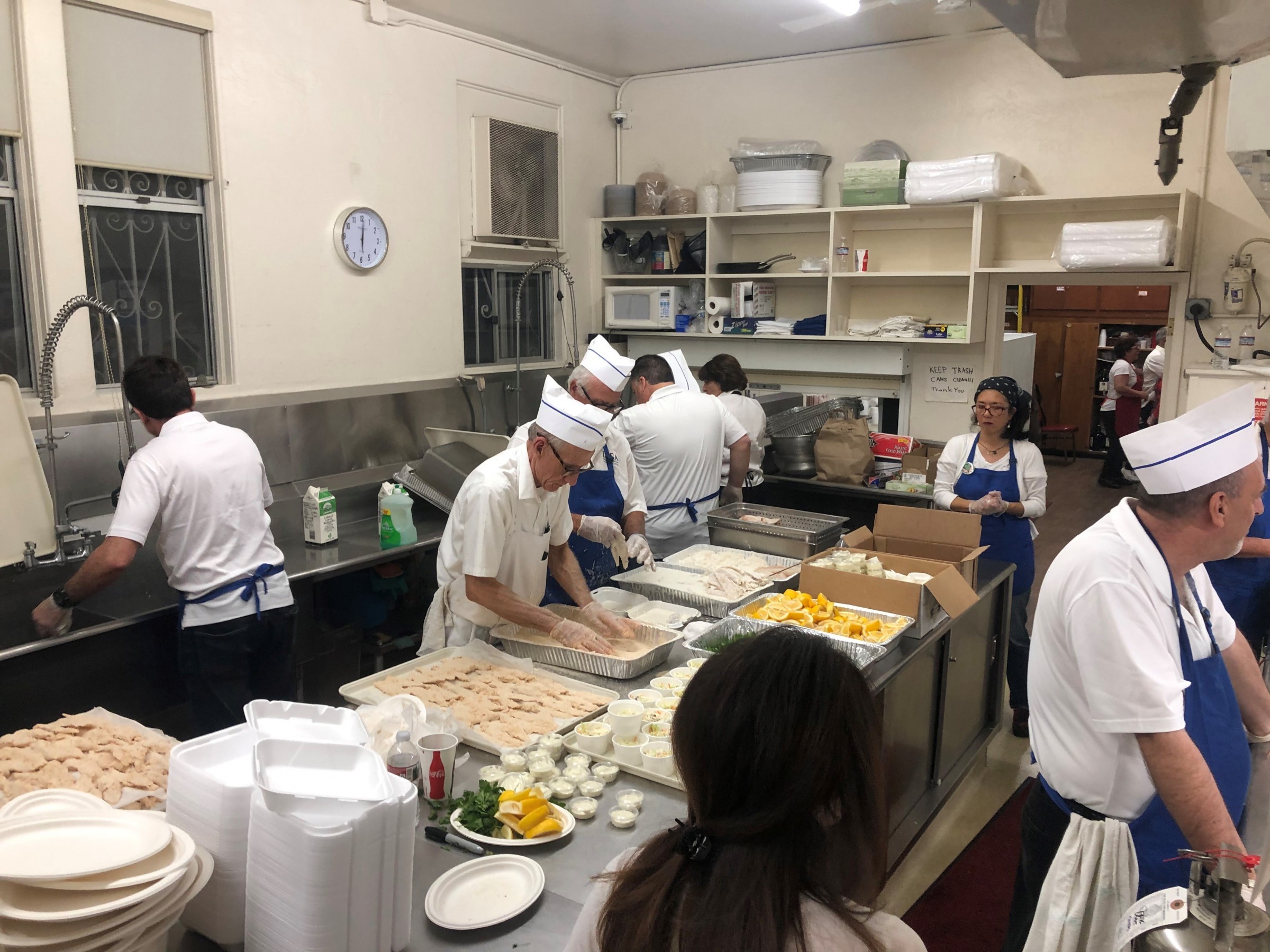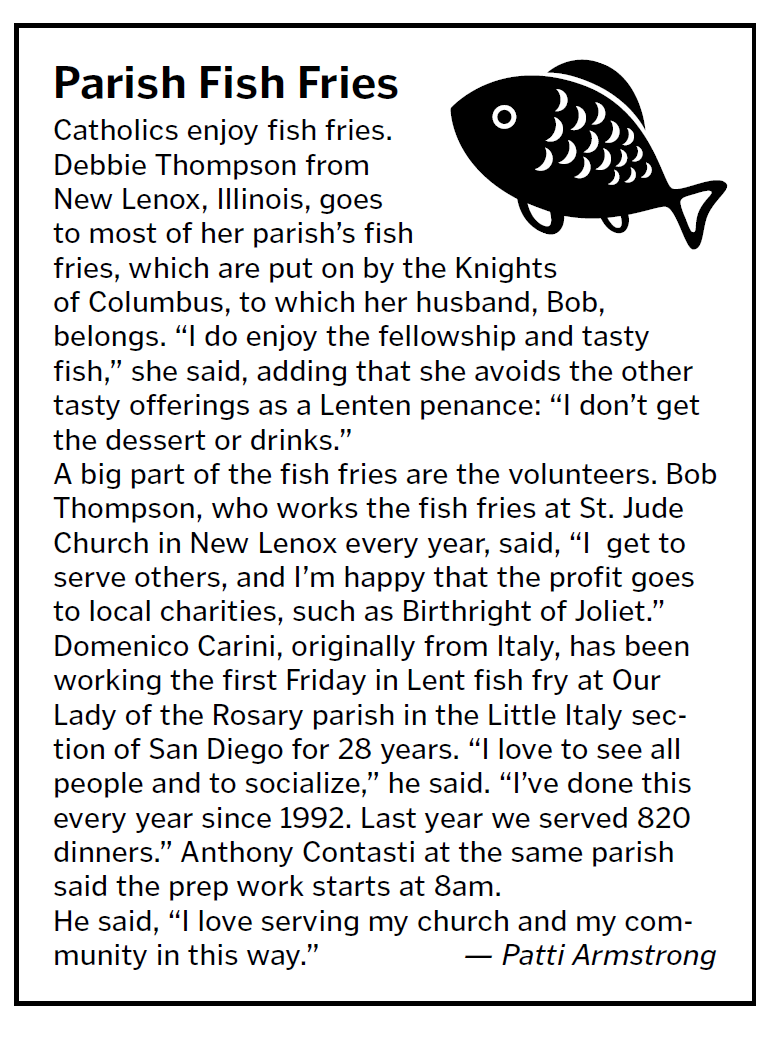Lent on the Menu: What Catholic America’s Having for (Friday) Dinner
Every Lent, Catholics make their mark in the modern world by impacting restaurants across the country.

Every Lent, Catholics make their mark in the modern world by impacting restaurant menus across the country. Catholics en masse abstain from meat on Ash Wednesday and Fridays during Lent.
According to Pew Research Center, 1-in-5 adults in the U.S. population are Catholic. In the traditional practice of sacrifice and self-denial during this penitential season, Catholics follow Lent more than any other Christian denomination, and even those generally not practicing will observe it in some way: Most Catholics (62%) do not eat meat on Fridays during Lent.
Neighborhood eateries and even big restaurant chains figured out that Catholics mean good business during Lent, so they added fish to their menus to attract Catholic customers. The Lenten rule regarding abstinence and fasting, according to the U.S. Conference of Catholic Bishops (USCCB), is that every person 14 years or older must abstain from meat on Ash Wednesday and Fridays in Lent, and everyone from 18 to 59 must fast on Ash Wednesday and Good Friday.
Before 1966, it was a sin for Catholics to eat meat on all Fridays in observance of Jesus dying on the cross on Good Friday. But that year, Pope St. Paul VI and many national bishops’ conferences — including the U.S. — allowed Catholics to replace “no meat” with another form of penance. They issued a “Pastoral Statement on Penance and Abstinence” but expressed a hope that “the Catholic community will ordinarily continue to abstain from meat by free choice as formerly we did in obedience to Church law.”
The Church never said to substitute meat with fish. But since meat is generally considered to be the flesh of warm-blooded land animals, cold-blooded water-dwelling creatures became a part of the culture of the members of the Catholic Church for days of abstinence.
Other — and More — Fish to Fry
There are so many Catholics following the rule of abstinence during Lent that the smell of frying fish fills the air on Fridays in some neighborhoods. Gordon’s Food Service, a distributor to restaurants and other facilities across the country, advises restaurant owners to make sure their Christian customers know their preferred restaurants will also be observing Lent.
“Lifeway Research found 24% of consumers observe Lent,” the food service wrote. “If seafood and other offerings aren’t on your Lent menu, you could miss out.”
Kelly’s Pub & Eatery in Scranton, Pennsylvania, was once a business that missed out. It has been owned for 30 years by four Irish-Catholic sisters. According to one of the Kelly sisters, Joni Bonio (her married name), the restaurant is popular for the award-winning chicken wings, but was once dead on Fridays during Lent.
When they started offering a fish fry during Lent around 27 years ago, things turned around. “We started with just 10 pounds of haddock the first year,” Bonio said. “Now we go through 140 pounds during Lent.”

Another Kelly sister, Tricia Laboranti (her married name), explained that the restaurant is located in an old Catholic part of town. “It has changed a lot over 30 years,” she said.
However, many customers will travel from across town for the Lenten fish fries.
Immediately west of the Keystone State, in Ohio, Cleveland Magazine publishes an annual “Fish Fry” guide because “every year when fish fry season starts, we embrace the culinary event like a pair of dad jeans.” One popular place is the Cleveland Donauschwaben, a German-American cultural center that serves 1,000 fish dinners every Friday during Lent.
It actually operates as a private club most of the year, but because it has its own restaurant, it welcomes the community for these dinners, using the club’s large main hall with help provided by volunteers as a fundraiser for the center.
According to Erica Rounds, administrative assistant at the center, the fish dinners start the Friday before Ash Wednesday as a sort of “warm up.”
“We play German music, and it’s a fun time,” she said. “People get seated together with others at big tables and meet new people. Everyone loves it.”
National Chains Lured — and Hooked
Although there is a neighborhood charm to the fish-fry season, even national chains have jumped in. USA Today recently announced the “Fish War of 2020,” where Arby’s, famous for its roast-beef sandwiches, is trolling McDonald’s Filet-O-Fish with a limited-time “Crispy Fish” sandwich and a “Fish n’ Cheddar” sandwich, telling customers to come to the house of beef for them instead.
Those are fighting words for McDonald’s, where the Filet-O-Fish sandwich was specifically created for Catholics in 1963. McDonald’s restaurant-owner Lou Groen was losing his shirt every Friday at his Cincinnati franchise while people lined up at the seafood restaurant down the street. He convinced company founder Ray Kroc to give his fish sandwich a try. It was an instant hit, saved the franchise, and became a permanent menu item. It still does well at the original franchise, now owned by Groen’s granddaughter Erica (Groen) Shadoin. The location sells an average of 520 fish sandwiches a day; 19% of receipts during Lent.
Better known for its root-beer floats than its seafood fare, A & W Restaurant, like dozens of other national chains, is not picking a fight with anyone; it simply wants in on all the Lent-observant customers. Sarah Mueller, senior vice president of marketing and development for A & W, explained that the chain is running three different specials, since they have 245 stand-alone A & W locations in the U.S. and around 325 others that share space with KFC and Long John Silver’s. At some locations, fish is offered all year, but during Lent, all locations offer that option along with special deals. “We’ve been doing it for at least 10 years, based on customer demand,” Mueller said. Although the A & W menu may be a matter of business for her, as a Catholic, she also chooses fish on Fridays. “My mom works the fish fry every year at St. Joseph’s Church in Louisville, Kentucky,” she said. “My ancestors even built that church. Fish during Lent has always been a part of my upbringing.”

National publications such as USA Today, in its business section, assemble Lenten restaurant guides, and the popular discount app EatDrinkDeals, puts out an annual guide for Lent that is updated throughout the season. Nation’s Restaurant News, a magazine for the foodservice industry, releases news of seafood trends just before Lent, according to its food editor, Bret Thorn. “There is a new trend,” he said, “toward restaurants promoting plant-based protein instead of seafood for Lent this year.” He said that Lent is an important part of their food coverage.
Lisa Jennings, West Coast bureau chief for the magazine, agreed that the rise of plant-based alternatives is making it easier than ever to avoid meat, although the trend also raises a new question.
“If you give up meat for Lent,” she asked, “are you missing the point if you still eat plant-based burgers that taste just like meat burgers?”
Good question — and bon appétit!
Patti Armstrong writes from North Dakota.
This article was updated after posting; new images were also added.
- Keywords:
- catholic living
- fish fries
- lent
- patti armstrong



















